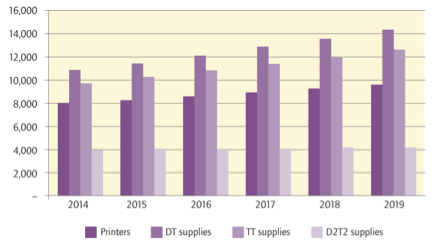The thermal printing market is forecast to grow from $32.8 billion in 2014 to $40.9 billion in 2019 at a compound annual growth rate (CAGR) of 4.3%, according to a new market study by Smithers Pira.
Of the two main segments of the market, printers are valued at $8.1 billion in 2014, projected to increase to $9.6 billion by 2019 at an annual growth rate of 3.4%, while the supplies segment is currently quantified at $24.7 billion and is predicted to rise to $31.4 billion by 2019, with an annual growth rate of 4.6%.
Direct thermal supplies are estimated to experience the greatest expansion over the forecast period growing from $10.9 billion to $14.4 billion at a rate of 5.3%, while thermal transfer consumables are expected to expand from $9.7 billion to $12.7 billion, approximately at the same pace.
The demand for dye diffusion consumables is anticipated to remain flat at $4.0 billion as the competing technologies, inkjet and laser printing, are gaining market share in the photo printing services.
Figure E.1 Global thermal printing market by component, 2014–2019 ($ million)

Source: Smithers Pira
The new study from Smithers Pira – The Future of Thermal Printing to 2019 – investigates global market trends in the thermal printing industry and presents forecasts for the five-year period from 2014 to 2019. Forecasts are given by technology, by end-user application and by geographic segmentation of the market.
The study examines the key factors contributing to the growth of thermal printing. High on the list are the productivity improvements gained through the deployment of automatic identification and data collection (AIDC) technologies such as barcodes, along with on-demand printing applications, security concerns, and product safety and anti-counterfeiting. The study also examines the key disruptive trends likely to pose threats to the thermal printing industry over the next five years, identifying the two greatest threats as inkjet and laser printing technologies.
Fundamentally, there are two main sets of driving forces that help to increase the size of the thermal printing market. First there is the general economic growth that affects the level of use and activity of the existing printing applications with direct impact on the consumption of thermal supplies. The second group involves the factors that influence end users' decisions in selecting thermal printing to solve their business problems, generally based on the unique benefits and inherent advantages of the technology.
The rapid expansion of wireless technology, specifically Bluetooth, WiFi and WLAN (wireless local area networks), has enabled the growth of thermal printers in both mobile and stationary applications as printer manufacturers integrate wireless connectivity into their products.
The Asia-Pacific region is the largest market for thermal printing, estimated at $11.3 billion in value and 34% of the global demand in 2014. The region is expected to maintain its first place position over the next five years, with a projected annual growth rate of 5.6% taking its market share up to 36.5%.
The second largest market is North America, with an estimated value of $8.8 billion in 2014, and Western Europe follows in third place with an estimated value of $7.5 billion in 2014.
Based on extensive primary research, The Future of Thermal Printing to 2019 investigates how the global thermal printing industry continues to grow and evolve, finding new markets and new applications. It explores the key drivers for the thermal printing industry and provides critical global market forecasts segmented by end-use, geography, media type, print process and equipment – ready to plug straight into your business plan.
www.smithers.com





























































































